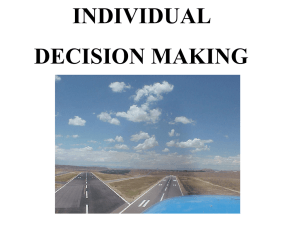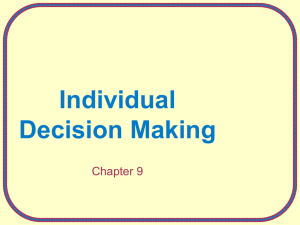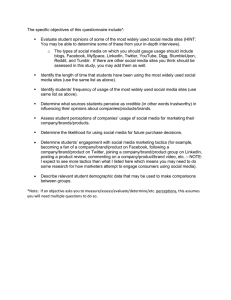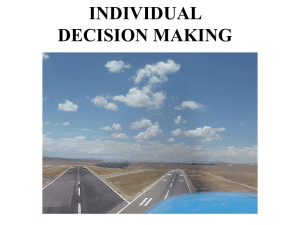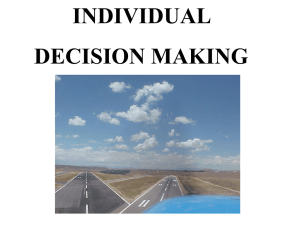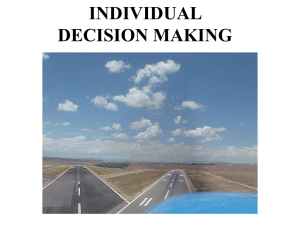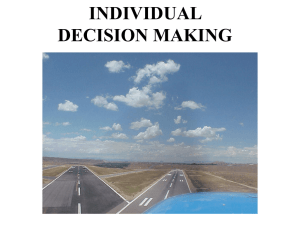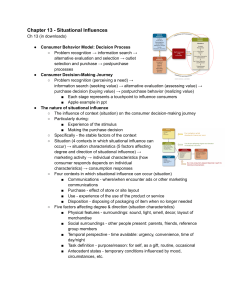INDIVIDUAL DECISION MAKING
advertisement
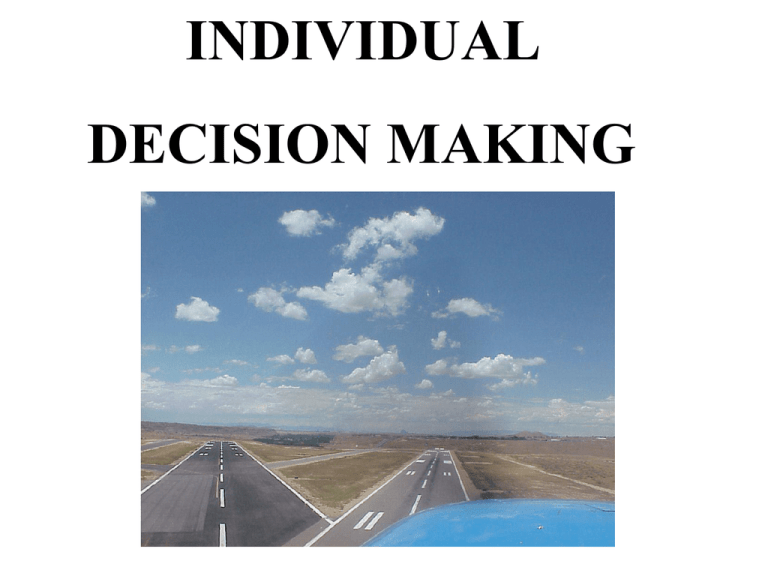
INDIVIDUAL DECISION MAKING The Purchasing Process Why do we buy anything? Purchases are made in response to a problem Consumers are therefore problem solvers Most research has viewed consumer as a rational decision maker trying to maximize utility of purchases Why is it important to know this? Products and services can be developed to solve consumers problems The attributes that are important to consumers can be emphasized Promotional strategies can be tailored to provide the types of information most likely to be effective And in the right format CONSUMER EFFORT IN MAKING DECISIONS You’ve had your car now for 7 years and it’s in need of constant repair. What decision process do you go through in purchasing a new one? Extended Problem Solving consumer tries to collect as much info as possible each product alternative is carefully evaluated initiated by a motive central to the self-concept decision perceived to carry a fair degree of risk engaged in when you are trying to satisfy an important need or if you have limited knowledge of the product or service Your toaster is now toast. What process do you go through in purchasing a new one? Limited Problem Solving Moderate amount of time and effort spent on information search and evaluation buyers aware of product class but not brands and their features. people use decision rules to chose among alternatives some prior experience or knowledge of the product or service Most purchases fall into this category. Your at the gas station paying for your gas when you have an uncontrollable urge to buy a chocolate bar. How do you decide which one to buy? Habitual Decision Making Only minimal search for, and evaluation of, alternatives. Little or no conscious effort Decisions are routine Brand Loyalty: consistently buy the same things Store Loyalty: consistently shop at same store Stages in Consumer Decision Making PROBLEM RECOGNITION INFORMATION SEARCH EVALUATION OF ALTERNATIVES PRODUCT CHOICE CONSUMPTION & LEARNING PROBLEM RECOGNITION How do you recognize a need for a product? when there is a difference between an actual state and a desired state and that requires resolution. In this case it was need recognition – something was lacking opportunity recognition - something to be gained Once You’ve recognized you have a problem what motivates you to resolve the problem? how big the difference is between the desired and actual states the relative importance of the problem Can marketers stimulate consumers’ recognition of needs? What is primary demand? The total demand for all brands in a product category. E.g. for specialty coffee shops = Starbucks + Second Cup + Grabbajabba + etc. When breaking open a new product category your first job is to create primary demand E.g. at one time there were no personal data assistants Then Apple introduced its Newton MessagePad. The task of Apple at that time was to create primary demand, not secondary demand because nobody knew what a PDA was or how it could be used to help them Secondary demand the demand for a given brand in a category brand competition Eg. Demand for AT&T = Market share INFORMATION SEARCH FOR WHAT ARE WE SEARCHING? Evaluative criteria Existence of alternatives Performance of alternatives on the criteria WHERE WILL WE SEARCH? Internal Sources – Previous searches – Personal experiences – Passive, low-involvement learning External Sources –Personal sources –Independent sources –Marketing sources –Experiential sources (e.g. sales people, packaging) CLASSIFYING SEARCHERS Nonsearchers – Use little to no information – “one-store” shoppers Information Searchers – Use three types of information – Visit four stores Extended Information Searchers – More than information searchers! WHAT DETERMINES THE EXTENT OF THE SEARCH? Benefit vs. Cost of Search –Market Characteristics Range of prices Number of alternatives Store distribution Information availability DETERMINANTS, CONTINUED –Consumer Characteristics Experience/Knowledge Shopping Orientation Perceived Risk Social Status Age and Household Life Cycle RISK FACTORS More time and effort is spent in the buying process when there is a high risk factor physical risk - to health - drugs, potentially dangerous items financial risk - high priced items social risk - to social status, symbolic products functional risk - picking the wrong product and can’t then afford to buy alternative psychological risk - to self esteem, feeling guilty DETERMINANTS, CONTINUED Product Characteristics – Price – Product Differentiation – Positive/Negative Products DETERMINANTS, CONTINUED Situational Characteristics – – – – – Time Availability Purchase for Others Pleasant Surroundings Social Surroundings Physical/Mental Energy Do consumers always search rationally? Biases in Decision Making Loss aversion 1. You've just been given $1,000 -- and two options. • Option A guarantees you an additional $500. • Option B lets you flip a coin: Heads, you get another $1,000; tails, you get nothing more. Which would you choose? 2. You've been given $2,000 -- and two options. • Option A guarantees that you will lose $500. • Option B lets you flip a coin: Heads, you lose $1,000; tails, you lose nothing. Which would you choose? People feel the pain of a loss more strongly than the pleasure of an equal gain. Sunk cost fallacy As the president of an airline company, you have invested $10 million of the company's money into a research project. The purpose was to build a plane that would not be detected by conventional radar. When the project is 90 percent completed, another firm begins marketing a plane that cannot be detected by radar. Also, their plane is much faster and far more economical than the plane your company is building. The question is: should you invest the last 10 percent of the research funds to finish your radar-blank plane? NO - It makes no sense to continue spending money on the project. YES - Since $10 mil. is already invested, I might as well finish it. Rationality - The investment size is irrelevant to the decision whether to continue or not Surrogate indicator: readily observable attribute of a product used to represent the performance level of a less observable attribute e.g., price and brand name are often used by consumers as surrogate indicators of quality EVALUATION OF ALTERNATIVES How do consumers narrow down the alternatives and choose one? How Many brands of Mini vans can you think of? evoked set The set of choices/brands that come to mind for purchase (retrieval set) Plus products prominent in the environment Important for marketer to get into the evoked set - these are the brands that will be evaluated first inert set brands which person is aware of but considers unacceptable inept set brands which consumer is unaware of New brands will be accepted into the evoked set but not brands which have been rejected. Therefore important that it performs well when first introduced Ford Edsel Ford Edsel 1958 (63,110); 1959 (44,891); 1960 (2,846) Radical styling, chrome-laden and gadget-filled big car in a small car market The pre-introduction publicity, which lasted for a year, created a super-car perception by consumers, which the Edsel failed to live up to. gained a reputation as being unreliable, expensive and prone to breaking down every thousand miles. MARKETING STRATEGIES – Habitual decision, brand in evoked set Maintenance – Habitual decision, brand not in evoked set Disrupt – Limited decision, brand in evoked set Capture – Limited decision, brand not in evoked set Intercept – Extended decision, brand in evoked set Preference – Extended decision, brand not in evoked set Acceptance What is it? HP OfficeJet G85 All-in-one scanner/copier/fax/printer Product Categorization Consumers tend to put all products into mental categories based on similarities and differences. Categorization is the process of understanding what something is by relating it to prior knowledge For example, when combination phone/fax/printers came out, they were categorized by customers as a phone – not a multifunction device. This is because they don’t have an established category for multifunction devices, so they just stick the new product in the phone category . Products are categorized in levels Super-ordinate level Laundry Detergent Liquid Tide Powder Wisk Tide Wisk Basic level Sunlight Subordinate level PRODUCT POSITIONING The place a product or service occupies in consumers' minds on important attributes relative to competitive offerings. Success of a positioning strategy often hinges on the marketers ability to convince consumer that product should be considered within a given category. Which is the sports car? Porsche Which is more prestigious? Mercedes Cadillac The real education problem of companies introducing new products in generating primary demand is to get customers to properly categorize the product. Strategic Implications of Product Categorization Locating Products • Where do you find wooden matches in the grocery store? • Where do you find soya sauce? Stimulating Interest Defining Competitors •Who are WestJets’ competitors Positioning and Repositioning What are some dimensions, or characteristics, that you might use to assess business schools? On each of these dimensions, where would you position relative to one another U of Toronto, U of Calgary, U of L, Mount Royal College REPOSITIONING changing the place an offering occupies in consumers' minds relative to competitive offerings. Mount Royal College has decided to reposition itself as a premier business school. What do you suggest they do to achieve this? EVALUATIVE CRITERIA When comparing products or services what criteria do you use? functional attributes Which margarine do you buy? And Why? determinant attributes • differentiators How can Marketers influence what attributes are important HEURISTICS "rules of thumb" people use to make judgements and decisions. • never buy a car in the first model year (choice heuristic) • if buying a computer, go to Future Shop for the best deal (search heuristic) Signals - infer hidden attributes from observable ones Covariation - usually vary with quality • length of time in business • country of origin • price • brand • retail outlet Situational effects on Consumer Behaviour factors over and above the person and the product i.e the situation can influence purchasing behaviour. 1. Behavioural/social - purchases tailored to specific occasions 2. Situational self image - who am I right now, feelings, role, ethnicity 3. Purchasing situation store surroundings (smells, temperature, sights, sounds can significantly influence consumption) social surroundings - eg. restaurant seating 4. Usage situation - time of day, in conjunction with other products The Purchase Environment Non-Store Shopping Retailing as Theater Sales Person Key Elements Place-Based of Purchase Spontaneous Media Shopping Store Image Non-Store Shopping E- COMMERCE What are some of the advantages of E-commerce? Advantages can reach customers from around the world cuts out the middleman --- Disintermediated can boost sales by attracting people who don’t normally shop in stores increased convenience Innovative methods What are some of the Disadvantages competitors can reach customers from around the world Some products difficult to sell over the Internet. E.g., clothes, food Retailing as Theatre Store Image Colorful point of purchase displays can increase sales Atmospherics “design of space and various dimensions to evoke certain effects in buyers” The atmosphere has been shown to have more influence than the service itself in the purchase decision Colour Warm colours (red, yellow, and orange hue) tend to evoke consumer feelings of comfort and informality. Warm colors encourage quick decisions and work best for lowinvolvement purchase decisions. Cool colours (blue, green, and violet hues) are favoured when customers need time to make decisions. Children appear to favor brighter colors while adults favor lighter tones. Atmospherics Continued Lighting. Consumers examine and handle more items under bright lighting. Consumers spend more time at in-store displays with bright lighting. Increased levels of lighting produce more arousal, pleasure, and increase approach behaviors of consumers. Music Studies show background music directly influences consumer buying behavior and affects sales. Background music enhances customer’s perception of store’s atmosphere. Firms that played music in their facilities were thought to care more about consumers. Slow tempo music encourages customers to stay longer. Customers find music distracting in high-involvement decisions and soothing in low-involvement decisions. POSTACQUISITION The consumption, disposition, and postchoice evaluation of goods, services, and ideas. Consumer satisfaction is the overall attitude associated with a good or service after its acquisition and use. Satisfaction or dissatisfaction is the difference between what was experienced and what was expected. A consumer has a level of performance expectations for a product If, after use, performance is perceived as worse than expected. Then consumer will be dissatisfied. If, after use, performance is perceived as better than expected. Then consumer will be satisfied. MARKETING LESSON UNDER PROMISE AND OVER DELIVER

